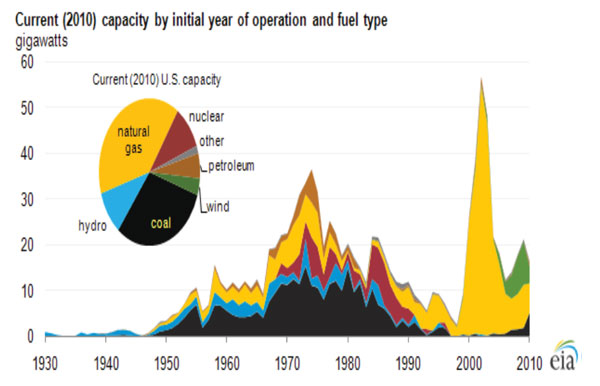New England gave birth to the Industrial Revolution in this country using water power. Now New England is struggling with decisions over how to power its future.
This week, Massachusetts approved permits for a gas-fired plant on the site of the old Salem Harbor coal and oil-burning power plant. Also announced this week was the closing of the largest coal plant in the region. See the good news in our blog about the Brayton Point retirement, which was built when John F. Kennedy was president.
In August word came that New England’s oldest nuclear power plant, Vermont Yankee will close late next year.
The New England power supply has been well stocked since the boom in building new natural gas-burning power plants. (The spike in building natural gas plants shown in the national chart below also occurred in New England.) Now with low natural gas prices, those plants are running more, and replacing the energy from coal plants. But that is really no solution.
The New England Independent System Operator, the electricity scheduling and reliability authority, has concerns that the natural gas supplies and pipeline infrastructure will not be adequate to meet demands of both power generation and winter heating. This week, the Federal Energy Regulatory Commission approved a unique Winter Reliability purchase of electricity resources not dependent on natural gas. This is a dramatic statement about the risks that gas infrastructure is not keeping up with a rush to gas.
UCS also has a report and a blog discussing the inability of meeting climate change needs by switching to natural gas. More broadly, UCS put forward a clean energy blueprint in 2009 that calls for energy efficiency and renewable energy to power the future.
New England has made major commitments to reducing energy needs through efficiency, and increasing use of renewables. Last month, UCS noted these accomplishments when several utilities combined their purchasing and contracted for “Wind power now competitive with conventional sources,” as it was described in the Boston Globe.
Massachusetts and other New England states are also seeing a burst of solar power installations that has exceeded expectations of sponsors, and surprised competitors and industry observers. Vermont, Connecticut, and Rhode Island have also made rooftop solar much more common. Policy makers in Massachusetts are in the midst of decision-making on the growth for solar in their state. In any of these states, you can call the governor or your state legislators to support this trend, and reduce our reliance on climate-changing fossil fuels, which is still the nature of natural gas.

